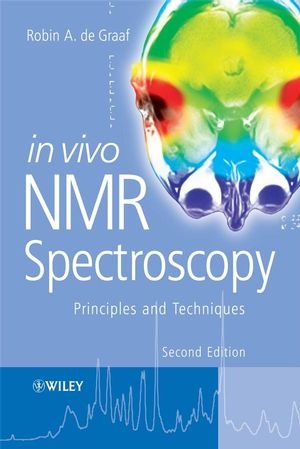
In Vivo NMR Spectroscopy
Wiley-Blackwell (Verlag)
978-0-470-02670-0 (ISBN)
- Titel erscheint in neuer Auflage
- Artikel merken
Robin A. de Graaf is the author of In Vivo NMR Spectroscopy: Principles and Techniques, 2nd Edition, published by Wiley.
Preface. List of Abbreviations and Symbols. 1 Basic Principles. 1.1 Introduction. 1.2 Classical Description. 1.3 Quantum Mechanical Description. 1.4 Macroscopic Magnetization. 1.5 Excitation. 1.6 Bloch Equations. 1.7 Fourier Transform NMR. 1.8 Chemical Shift. 1.9 Digital Fourier Transform NMR. 1.10 Spin-spin Coupling. 1.11 T1 Relaxation. 1.12 T2 Relaxation and Spin-echoes. 1.13 Exercises. References 41 2 In Vivo NMR Spectroscopy - Static Aspects. 2.1 Introduction. 2.2 Proton NMR Spectroscopy. 2.3 Phosphorus-31 NMR Spectroscopy. 2.4 Carbon-13 NMR Spectroscopy. 2.5 Sodium-23 and Potassium-39 NMR Spectroscopy. 2.6 Fluorine-19 NMR Spectroscopy. 2.7 Exercises. 3 In Vivo NMR Spectroscopy - Dynamic Aspects. 3.1 Introduction. 3.2 Relaxation. 3.3 Magnetization Transfer. 3.4 Diffusion. 3.5 Dynamic Carbon-13 NMR Spectroscopy. 3.6 Hyperpolarization. 3.7 Exercises. 4 Magnetic Resonance Imaging. 4.1 Introduction. 4.2 Magnetic Field Gradients. 4.3 Slice Selection. 4.4 Frequency Encoding. 4.5 Phase Encoding. 4.6 Spatial Frequency Space. 4.7 Fast MRI Sequences. 4.8 Contrast in MRI. 4.9 Parallel MRI. 4.10 Exercises. 5 Radiofrequency Pulses. 5.1 Introduction. 5.2 Square RF Pulses. 5.3 Selective RF Pulses. 5.4 Pulse Optimization. 5.5 DANTE RF Pulses. 5.6 Composite RF Pulses. 5.7 Adiabatic RF Pulses. 5.8 Pulse Imperfections and Relaxation. 5.9 Power Deposition. 5.10 Multidimensional RF Pulses. 5.11 Spectral-spatial RF Pulses. 5.12 Exercises. 6 Single Volume Localization and Water Suppression. 6.1 Introduction. 6.2 Single Volume Localization. 6.3 Water Suppression. 6.4 Exercises. 7 Spectroscopic Imaging and Multivolume Localization. 7.1 Introduction. 7.2 Principles of Spectroscopic Imaging. 7.3 Spatial Resolution in MRSI. 7.4 Temporal Resolution in MRSI. 7.5 Lipid Suppression. 7.6 Spectroscopic Imaging Processing and Display. 7.7 Multivolume Localization. 7.8 Exercises. 8 Spectral Editing and Two-dimensional NMR. 8.1 Introduction. 8.2 Scalar Evolution. 8.3 J-difference Editing. 8.4 Practical Considerations of J-difference Editing. 8.5 Multiple Quantum Coherence Editing. 8.6 Heteronuclear Spectral Editing. 8.7 Polarization Transfer - INEPT and DEPT. 8.8 Sensitivity. 8.9 Broadband Decoupling. 8.10 Two-dimensional NMR Spectroscopy. 8.10.1 Correlation Spectroscopy (COSY). 8.10.2 Spin-echo or J-resolved NMR. 8.10.3 Two-dimensional Exchange Spectroscopy. 8.11 Exercises. 9 Spectral Quantification. 9.1 Introduction. 9.2 Data Acquisition. 9.3 Data Pre-processing. 9.4 Data Quantification. 9.5 Data Calibration. 9.6 Exercises. 10 Hardware. 10.1 Introduction. 10.2 Magnets. 10.3 Magnetic Field Homogeneity. 10.4 Magnetic Field Gradients. 10.5 Radiofrequency Coils. 10.6 Radiofrequency Coil Types. 10.7 Complete MR System. 10.8 Exercises. Appendix. A1 Matrix Calculations. A2 Trigonometric Equations. A3 Fourier Transformation. A3.1 Introduction. A3.2 Properties. A3.3 Discrete Fourier Transformation. A4 Product Operator Formalism. A4.1 Cartesian Product Operators. A4.2 Spherical Tensor Product Operators. References. Further Reading. Index.
| Erscheint lt. Verlag | 1.1.2008 |
|---|---|
| Verlagsort | Hoboken |
| Sprache | englisch |
| Maße | 175 x 249 mm |
| Gewicht | 1168 g |
| Themenwelt | Medizinische Fachgebiete ► Radiologie / Bildgebende Verfahren ► Kernspintomographie (MRT) |
| Naturwissenschaften ► Chemie ► Analytische Chemie | |
| ISBN-10 | 0-470-02670-7 / 0470026707 |
| ISBN-13 | 978-0-470-02670-0 / 9780470026700 |
| Zustand | Neuware |
| Haben Sie eine Frage zum Produkt? |
aus dem Bereich



